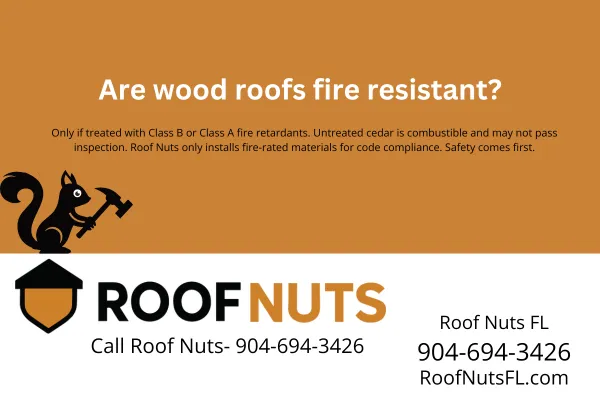
Are wood roofs fire resistant?
FAQ: Are Wood Roofs Fire Resistant?
Q: Are wood roofs fire resistant?
A: Only if the wood is treated with a fire-retardant to meet Class B or Class A fire ratings. Untreated cedar shakes or shingles are combustible and may not pass inspection in Florida. Roof Nuts only installs fire-rated materials to meet local building codes and keep your home safe.
Understanding Fire Ratings for Wood Roofs
Class A – Highest rating; offers effective resistance to severe fire exposure. Often required in high-risk areas.
Class B – Moderate protection against fire spread.
Untreated wood – Highly flammable; not approved for most residential use in Florida’s building codes.
Fire-retardant treatments penetrate or coat the cedar, helping prevent ignition and slow down flame spread. These treatments are tested to ASTM E108 standards for roofing fire performance.
Florida Code Compliance
Under the Florida Building Code (based on IRC & IBC standards), roof coverings must meet minimum fire classification requirements for safety and insurance purposes. Installing non-rated cedar would risk failed inspections and potential insurance issues.
Roof Nuts ensures all wood roofing materials:
Are factory-treated for Class A or Class B fire resistance
Meet manufacturer and building code specifications
Come with documentation for permitting and inspections
Why Roof Nuts Only Installs Fire-Rated Cedar
Safety First – Reduces the chance of roof ignition from embers or nearby fires.
Code Approval – Passes inspection without delays.
Insurance Acceptance – Meets underwriting requirements for homeowner policies.
FAQs from Florida Homeowners
Q: Can existing untreated wood roofs be treated for fire resistance?
A: Retrofitting is possible with spray or brush-on treatments, but results may not match factory treatments and may not achieve Class A certification. Always check with your local building department before investing in field-applied treatments.
Q: Do fire-retardant treatments affect the look of cedar roofs?
A: Most treatments are designed to preserve the natural cedar appearance. Over time, cedar will still weather to a silver-gray patina.
Q: How long does fire protection last?
A: Factory-applied treatments can last decades, but Florida’s humidity, rain, and UV exposure may require periodic re-treatment depending on product warranties.
